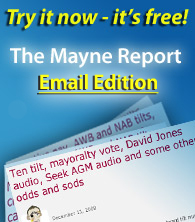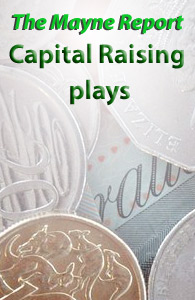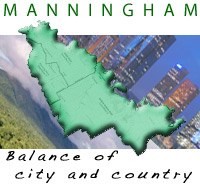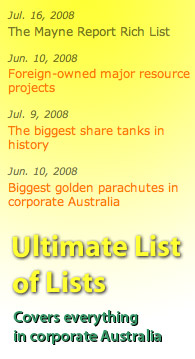Babcock sails through its second AGM
By Stephen Mayne
January 14, 2008
The governance issues at Babcock are getting worse but they sailed through their 2006 AGM without too many problems, as this story in Crikey on May 28 attests.
Despite some pre-publicity suggesting institutional rumblings, Babcock & Brown got through its second AGM with no meaningful opposition to its pay or board, although we did manage to slug it out for more than two hours at the Four Seasons in Sydney on Friday.
The proxy advisory firms ISS and CGI, which often play the role of kingmaker at AGMs, apparently took issue with a couple of resolutions but didn't muster much support, although this largely reflects the fact that 47% of B&B's shares are still owned by current and former executives.
Whilst John Singleton's STW Holdings copped a 44.5% protest vote (62.78 million proxies in favour and 50.34 million against) over its remuneration report on Thursday due to concerns about CEO Russell Tate's pay structure, Babcock was applauded for comprehensively explaining how its lucrative pay system works.
Macquarie Bank will certainly take heart that the company with Australia's second fattest pay packets got through its first remuneration report vote with just 3.47% of the directed proxies against.
Given that the business press routinely fails to report voting outcomes, these were the three most opposed B&B resolutions:
| Resolution | Proxies in favour | Proxies against | Primary vote in favour |
| Re-election of James Fantaci |
87.98m | 12.49m | 87.57% |
| Martin Rey's $250,000 options |
72.32m | 2.6m | 96.58% |
| Remuneration report | 96.8m | 3.43m | 96.53% |
You've got to feel a little sorry for Fantaci, who runs the North American operation out of New York and was the company's seventh employee when he joined 25 years ago. He's joined the rare "re-elected with less than 90% support" club because Babcock still doesn't have a clear majority of independent directors.
The addition in April of new independent Joe Raby, the former CEO of US investment bank Donaldson Lufkin Jenrette before it was sold to CS First Boston for $US11.5 billion in 2000, is quite a coup for Babcock although it still has an executive chairman in Jim Babcock and there is some dispute about whether deputy chairman Elisabeth Nosworthy is genuinely independent given her deep affiliation with various Babcock associates.
The Australian Shareholders Association had a big whack at Martin Rey's options, mainly because they were priced at $17.25 – the recent book build price when $330 million was raised by staff selling down from 54% to 47%. Sure, the stock is now up around $20 after Friday's profit upgrade, but giving an executive 250,000 performance-related options at $17.25 is a drop in the bucket compared with previous hurdle-free issues and the massive cash bonuses on offer.
For instance, CEO Phil Green was issued 800,000 hurdle-free options at $5 the day before the float in October 2004. I had a decent whack at this during the debate about the remuneration report and later directly asked Ernst & Young auditor Mark O'Sullivan whether it was a "material mis-statement" to value them at $1.27 a share or $1.02 million in total when calculating that Green's overall package was worth $10.3 million in 2004.
Based on Friday's close of $19.97, these 800,000 options are actually worth $12 million so Green's 2004 salary package is currently valued at $21.3 million – more than double what the 2005 annual report states, even though the auditor didn't sign off until 30 March, 2006. Both remuneration committee chairman Ian Martin and O'Sullivan hid behind the lame accounting standard requiring historical accounting on the day of issue in defending this material under-statement of the CEO's package.
With up to $1 billion in option valuation understatement across our top 100 companies over the past five years, it really is time for Peter Costello to step in and change the law because boards and auditors are getting away with signing accounts that, when it comes to truly revealing what a CEO is paid, are often a crock.
Babcock AGM follow-up in Crikey on May 30, 2006
By Stephen Mayne, small investor in four Babcock vehicles
Babcock & Brown's pugnacious CEO Phil Green blithely told the press after Friday's AGM that his company would float "four or five" new satellites over the coming year, in keeping with the pace he set in 2005.
It is the myriad fees coming to Babcock & Brown from these various vehicles which have driven its strong profits and share price since the 2004 float, but the performance has started to wobble in recent months, particularly after it was revealed Babcock & Brown Wind had paid a whopping $33 million in performance fees for the December half. As some shocked commentators pointed out at the time, cash flow was only $15.8 million for the half, so investors copped a net loss of $18.3 million after the fee raid.
No independent directors or institutional investors should tolerate gouging, so I asked the Babcock board on Friday what sort of protection they had in place to stop themselves from being sacked as manager.
After being told Macquarie Bank chairman David Clarke usually says "nothing, just our good performance" when asked a similar question, Phil Green adopted that strategy. But is that really the case? What would happen if a group of shareholders petitioned an EGM to sack Babcock as manager? Are all the circumstances in the public arena? There may be some interesting developments on this front in the months ahead.
When it came to the re-election of Babcock independent director and long-standing ASX director Michael Sharpe, I asked if he took an interest in the manager termination provisions in various Babcock satellites and whether he was satisfied with the level of disclosure. Acting chairman Elizabeth Nosworthy claimed Sharpe was wasn't on the board of any satellites so he wasn't responsible but Sharp then went on the public record saying he is "extremely interested" in such disclosures because "it goes to our reputation" and he is satisfied "our transparency is of a high standard".
Babcock, just like Macquarie Bank, pushes the corporate governance envelope with these satellites because there are huge conflicts of interest, countless related party transactions and boards which are not exactly full of genuinely independent directors. For instance, I reckon much of Friday's profit upgrade will come from fat fees that will flow every which way after Babcock & Brown Capital's $8 billion agreed bid for Irish telco Eircom.
Here is a summary, ranked from worst to best, of how the various Babcock vehicles have performed and a list of the independent directors.
Babcock & Brown Capital: Floated in Feb 2005 with $1 billion raised at $5 a share. Now just $4.03 after $8 billion Eircom tilt.
Independent directors: Robert de Crespigny (chair), Kerry Roxburgh and Bill Waivish
Babcock & Brown Infrastructure: Stable for the year, but down from $1.87 last September to a recent low of $1.46 before Phil Green bought.
Independent directors: David Hamill (chair), Leigh Hall, Andrew Tyndale and Barry Upson
Babcock & Brown Wind: $1.40 float price in November 2005, then tanked from high of $1.93 to $1.60 after $33 million in fees ripped out.
Independent directors: Douglas Clemson, Tony Battle, Mr Nils Andersen (Babcock executive Peter Hofbauer is chairman)
Everest Babcock & Brown: issued 60 million shares at $5 to raise $300 in May 2005. Now $5.65 after restructure announced last week.
Independent directors: Trevor Gerber (chair), Kerry Roxburgh, Keith Ince and Olev Rahn
Babcock & Brown Japan: Floated as $1 units in April 2005, now $1.75
Independent directors: Allan McDonald (chair), Paula Dwyer and John Pettigrew
Babcock & Brown Environment: Shares up substantially but hard to follow its various early incarnations
Independent directors: JE Graham, Tony Leibowitz and Barry Murphy (Babcock CEO Phil Green is chairman)
Babcock & Brown: rocketed from $5 float price in October 2004 to $19.97 on Friday:
Independent directors: Elizabeth Nosworthy (dep chair), Michael Sharpe, Joe Roby and Ian Martin
As you can see, some vehicles have independent chairs and others don't. However, the independence of people like Babcock & Brown Capital chair Robert de Crespigny is open to debate given he and Babcock together went the sword on Primelife founder Ted Sent.
Similarly, is Multiplex chairman Allan McDonald a genuinely independent chairman of Babcock & Brown Japan given the large number of property deals that the two firms do together? At the end of the day, both Babcock & Macquarie need to pay reputable independent directors who will sign off on their controversial dealings. Who has the better list is an issue we'll explore in the days ahead.
Copyright © 2024 The Mayne Report. All rights reserved






















